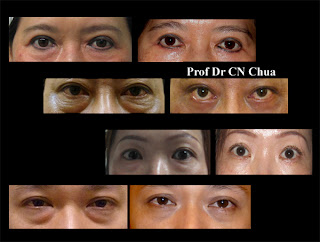Statistics show that in the USA the most common cosmetic surgery is breast implant whereas in East Asian countries double eyelid surgery (Asian blepharoplasty) tops the list. However, poor results from double eyelid surgery are often more difficult to disguise than breast implants as it would be impractal to wear dark glasses constantly to hide the imperfections than wearing bra. It is estimated that 10% of patients who underwent the procedures have complications resulting from the procedure. Fortunately, the majority of these can be easily corrected. A good article (Strategies for a Successful Corrective Asian Blepharoplasty after Previously Failed Revisions. Chen et al. Plast. Reconstr. Surg. 114: 1270, 2004.) published a few years ago looked at patients who presented to their plastic centres with complications relating to double eyelid surgery and their management.
In the series of patients the authors encountered, most of the complications are disappearance of the double eyelids and upper eyelid asymmetry with unequal crease height, length, and shape. Other less common complications are blepharoptosis (droopy eyelids due to damage to the muscles that open the eye), supratarsal depressions (sunken upper eyelids from too much fat removal), lagophthalmos (problem with eyelid closure caused by too much skin being removed). The following pictures show some of these complications.
Disappearance of the double eyelids. This is a common complication of suture
technique but may occur with the incision technique. It is caused by lossening
of the adhesions between the skin creases and the levator
muscle. The treatment is reoperation.
Eversion of the eyelashes or lash ectropion. This is caused by inappropriate
suturing of the skin and levator muscle. Usually with time
or massage, the eyelid will return to normal.
Another common complication is asymmetry of the skin creases. Sometimes the differences
may be caused by swellings in which case the asymmetry will resolve with time.
However, if it is caused by poor markings at the starting of the surgery,
the treatment of choice is to reoperate usually on
the eye with higher skin crease.
High skin creases and sunken upper eyelids. This resulted from marking
the double eyelids too high and removing too much fat. The treatment is
to lower the skin creases and replace the lost fat either by moving the fat
downward from the upper eyelid or by fat grafting.
Ptosis or droopy eyelid, this resulted from accidental damage to the levator muscle.
Usually operation by resuturing the cut levator muscle is required.
Lagophthalmos or problem with complete eye closure is a less common
complication and usually occurs with new surgeons who excise too
much skin. Applying lubricant to the eyelid skin together with
massage, the lagopthalmos may reduce or disappear
but in severe cases, skin graft may be needed.


















































